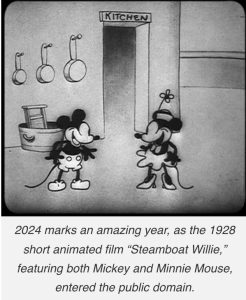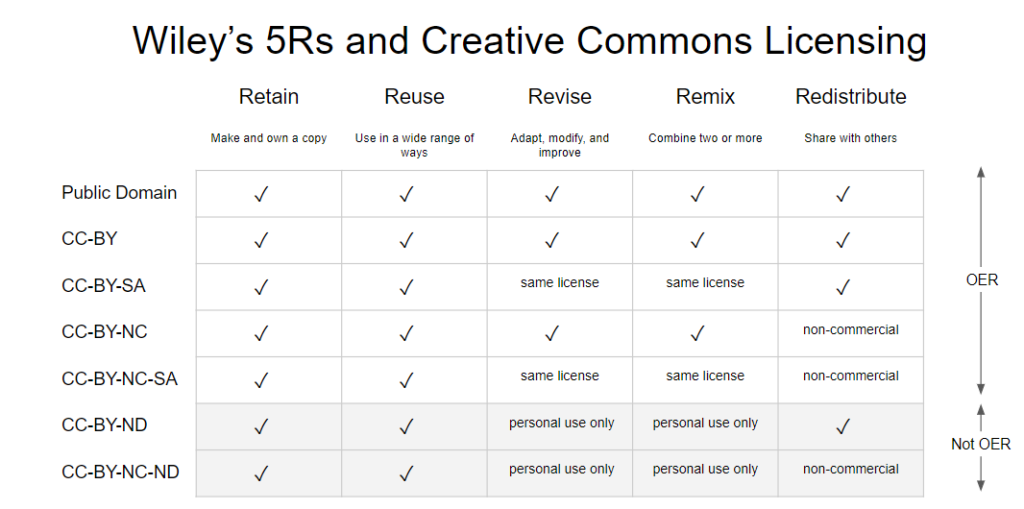Copyright Primer
Learning Objectives
By the end of this chapter, you will be able to:
- Define copyright and open licenses.
- Explain the purpose of copyright law in the United States.
This chapter is an adaptation of the chapter, “Copyright and Open Licensing”from the OER Starter Kit by Abbey Elder and is licensed under a CC BY 4.0 International license.
Before we begin searching for open materials, it is important to gain a basic understanding of copyright, licensing, and the impact on open resources. An open license is a vital component of an open educational resource. Because of this, it is important that you understand how open licenses work within copyright law.
View this brief (3 minutes and 46 seconds) video about open licenses and how they work.
Attribution: “Attribution and Fair Use: Copyright and in Open Education #1” by Abbey Elder is licensed CC BY 4.0.
Copyright Law
U.S. copyright law protects an author’s rights over their original creative works (e.g., research articles, books and manuscripts, artwork, video and audio recordings, musical compositions, architectural designs, video games, and unpublished creative works).[1] As soon as something is “fixed in a tangible medium of expression,” it is automatically protected by copyright. A resource is considered fixed when:
“its embodiment …by or under the authority of the author, is sufficiently permanent or stable to permit it to be perceived, reproduced, or otherwise communicated for a period of more than transitory duration.”[2]
In other words, an idea for a book you want to write is not protected by copyright, but the first draft of your manuscript is. Copyright protection ensures that the creator of a work has complete control over how their work is reproduced, distributed, performed, displayed, and adapted.[3] You do not need to register your resource with the U.S. Copyright Office for this to come into effect; it is automatic.
Public Domain
Works that are no longer protected by copyright are considered part of the public domain. Items in the public domain can be reused freely for any purpose by anyone, without giving attribution to the author or creator.[4]
 Public domain works in the U.S. include works whose creator died 70 years prior, works published before 1924, or works dedicated to the public domain by their rightsholder. The Creative Commons organization created a legal tool called CC 0 to help creators dedicate their work to the public domain by releasing all rights to it.[5]
Public domain works in the U.S. include works whose creator died 70 years prior, works published before 1924, or works dedicated to the public domain by their rightsholder. The Creative Commons organization created a legal tool called CC 0 to help creators dedicate their work to the public domain by releasing all rights to it.[5]
For a fascinating look at works that have recently entered the public domain, visit this blog post from The American Writers Museum. Recent additions include the animated film, Steamboat Willie and The House on Pooh Corner.
Open Licenses
All OER are made available under some type of open license, a set of authorized permissions from the rightsholder of a work for any and all users. The most popular of these licenses are Creative Commons (CC) licenses, customizable copyright licenses that allow others to reuse, adapt, and re-publish content with few or no restrictions. CC licenses allow creators to explain in plain language how their works can be used by others.[6]
Fair Use
If an OER is available under a copyright license that restricts certain (re)uses, you can make a fair use assessment for reproducing or adapting that work. However, having explicit permission is preferable. We do not recommend using fully copyrighted works in OER projects without written permission from the work’s rightsholder.
The Four Components of Creative Commons Licenses
| Attribution (BY) Proper attribution must be given to the original creator of the work whenever a portion of their work is reused or adapted. This includes a link to the original work, information about the author, and information about the original work’s license. | |
| Share-Alike (SA) Iterations of the original work must be made available under the same license terms. | |
| Non-Commercial (NC) The work cannot be sold at a profit or used for commercial means such as for-profit advertising. Copies of the work can be purchased in print and given away or sold at cost. | |
| No Derivatives (ND) The work cannot be altered or “remixed.” Only identical copies of the work can be redistributed without additional permission from the creator. |
These elements can be mixed and matched to create a total of six Creative Commons licenses.[7]
Choosing a License
Choosing a CC license can be confusing at first, but the online Choose a License tool can help. This tool generates a license based on which rights you want to retain and which you would like to give to users. For example, if you want to share your work and allow others to adapt it, but you do not want others to be able to sell your work, you might consider using the CC BY NC license.
Before you choose a license, keep in mind that an OER should be able to exercise all the 5 Rs of open content we discussed in the previous chapter. Not all of the CC licenses meet this definition. Specifically, the CC BY ND and CC BY NC ND licenses do not allow revising or remixing content, two of the most significant freedoms of OER for many instructors.

Implementing a CC License
Creative Commons has an online Marking Guide that demonstrates how to mark your CC license on different types of media. Making your license obvious on whatever item you are sharing is an important part of the dissemination process for OER: otherwise, users won’t know what license you’ve chosen! No matter the format, there are some standards you can follow:
- Make it clear
- Make it visible
- Provide links (to the license and the work)
- Copyright Law of the United States, 17 USC §102. https://www.copyright.gov/title17/92chap1.html#102 ↵
- Copyright Law of the United States, 17 USC §101. https://www.copyright.gov/title17/92chap1.html#101 ↵
- Copyright Law of the United States, 17 USC §106. https://www.copyright.gov/title17/92chap1.html#106 ↵
- Of course, standard citation procedures still apply for creative works in the public domain. You cannot claim another's work as your own. ↵
- Peters, Diane. "Improving Access to the Public Domain: The Public Domain Mark." Creative Commons Blog, October 11, 2010. https://creativecommons.org/2010/10/11/improving-access-to-the-public-domain-the-public-domain-mark/ ↵
- By assigning an open license to your work, you allow any user to exercise the rights allowed under the license, and cannot restrict reuse by certain individuals or parties without changing the license itself. ↵
- Note that the No Derivatives and Share Alike components are incompatible and cannot be combined under one license. ↵
A copyright license which grants permission for all users to access, reuse, and redistribute a work with few or no restrictions.
A set of open licenses that allow creators to clearly mark how others can reuse their work through a set of four badge-like components: Attribution, Share-Alike, Non-Commercial, and No Derivatives.
A legal doctrine that promotes freedom of expression by permitting the unlicensed use of copyright protected works in certain circumstances. In Canada, this is known as Fair Dealing.

